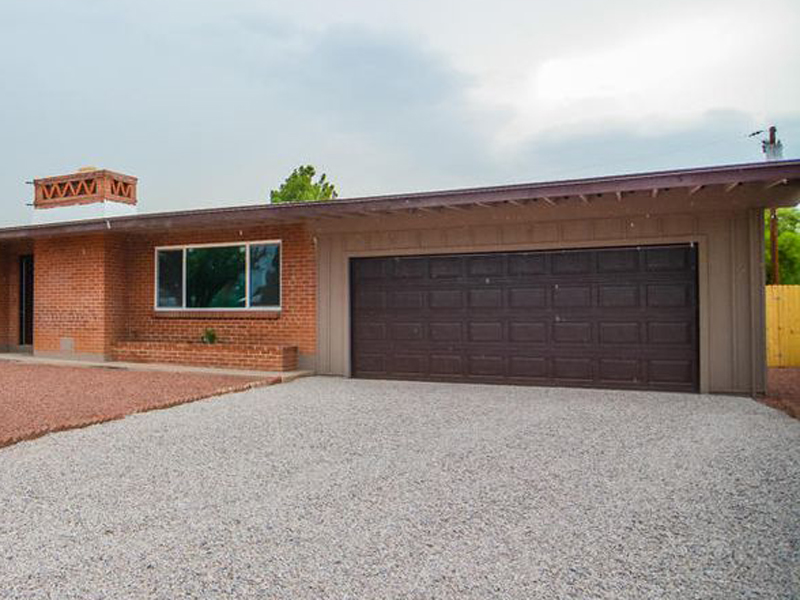Is Your Garage Door Stuck? Right here's What to Do Very first
When your garage door will not open, start with these important safety checks prior to trying any kind of fixings. First, make sure nobody is standing near the door and that cars are clear of the opening. Search for obvious indications of damages like busted panels, bent tracks, or hanging cords. If you see a snapped springtime or seriously damaged parts, stop right away and call an expert—-- these repair services call for customized devices and competence to deal with safely.

Examine These 6 Points Before Calling a Professional
Prior to presuming you require expensive repair work, go through this quick diagnostic list that fixes most garage door troubles:
-
Source of power: Verify the opener is connected in and the outlet is working
-
Remote batteries: Change dead batteries in your remote
-
Hands-on lock: Check if somebody accidentally engaged the hands-on lock
-
Blockages: Search for debris obstructing the door's course or sensors
-
Emergency situation release: Ensure the red emergency situation cord hasn't been pulled
-
Circuit breaker: Verify the garage circuit hasn't tripped
These straightforward checks resolve roughly 70% of garage door issues without requiring professional intervention.
10 Typical Reasons Your Garage Door Will Not Open
Recognizing why your garage door opener isn't functioning assists you select the right solution. Below are the most constant reasons homeowners experience:
Dead remote batteries stand for the simplest repair—-- when batteries pass away, the remote can't send signals to the opener. Power failures or stumbled breakers reduced electricity to the electric motor. Damaged springs protect against the door from raising properly and require prompt expert interest. Sensing unit imbalance causes security systems to obstruct door operation. Track obstructions quit rollers from relocating smoothly. Electric motor overload triggers automatic shutoffs when the opener discovers resistance. Restriction switch troubles perplex the opener about door placement. Cord damage interferes with the lifting system. Weather-related problems impact door movement throughout severe temperature levels. Element wear from age gradually decreases system efficiency.
Issue # 1: Dead Remote Batteries
When your wall button functions yet your remote does not, dead batteries are generally the culprit. The majority of garage door remotes make use of either 3-volt lithium or 12-volt alkaline batteries. Get rid of the back cover of your remote and examine the battery kind. Replace with fresh batteries and check the remote. If it still does not work, you might need to reprogram it to your opener. Consult your opener's handbook for details reprogramming guidelines, as the process varies by producer.
Trouble # 2: Power Supply Issues
Garage door power issues commonly originate from loose links or tripped circuits. Examine that the opener is strongly connected into its electrical outlet—-- vibration can loosen up links in time. Examine the electrical outlet with another tool to confirm it's functioning. Examine your home's breaker box for tripped circuits, especially if you have actually experienced storms or power fluctuations. GFCI electrical outlets may have tripped and need resetting. If the opener has power but won't react, the problem likely lies in other places in the system.
Problem # 3: Broken or Damaged Springs
Busted garage door springs are amongst one of the most harmful parts to manage. If you hear a loud bang from your garage or observe the door feels very hefty when attempting to raise manually, a spring has most likely snapped. Torsion springs run flat above the door, while expansion springtimes remain on either side. Never ever attempt springtime repair work yourself—-- these components keep incredible tension that can cause serious injury or death. Expert substitute normally sets you back $150-$300 yet guarantees your safety.
Issue # 4: Obstructed Safety Sensors
Modern garage doors feature safety sensing units that prevent closure when objects are discovered. These sensors can stop the door from opening if they're filthy, misaligned, or blocked by particles. Tidy sensing unit lenses with a soft towel and ensure nothing obstructs the invisible beam between them. Check that sensing units are correctly aligned—-- most have indication lights that show connection condition. Sensor problems frequently settle with straightforward cleaning and adjustment.
Issue # 5: Track Obstructions or Damages
Garage door tracks overview rollers as the door moves up and down. Dirt, debris, old oil, or little objects can jam the system. Inspect tracks visually and remove any kind of blockages with a brush or cloth. Look for dents, flexes, or bending that could restrain smooth procedure. Minor track changes are possible for helpful property owners, but significant damages calls for professional fixing to stop further troubles or security risks.
Issue # 6: Garage Door Opener Electric Motor Issues
When the garage door motor runs however the door does not move, several issues could be responsible. The motor may be overwhelmed and shutting off as a safety measure. Gear wear, especially in older devices, can prevent correct procedure. Chain or belt drive troubles impact power transmission. If you listen to uncommon grinding, clicking, or humming sounds, stop using the opener quickly. Electric motor repair services often cost more than substitute, specifically for units over ten years old.
Step-by-Step DIY Troubleshooting Guide
Follow this methodical technique to garage door repairing while prioritizing safety and security throughout the procedure:
Action 1: Evaluate the wall switch initially. If it works yet the remote doesn't, concentrate on remote concerns. If neither works, inspect power supply.
Step 2: Check out the hand-operated release cable. If it's been drawn, the opener is disengaged from the door. Press the trolley back to reconnect.
Action 3: Manually test the door by disengaging the opener and attempting to lift the door by hand. It should relocate smoothly and stay in location when half-open.
Tip 4: Evaluate visible elements for damage, paying unique focus to springs, cable televisions, and tracks.
Step 5: Inspect all security attributes consisting of sensing units, limit switches, and auto-reverse functions.
Action 6: Test different controls (remote, wall switch, keypad) to isolate the trouble source.
Constantly use safety glasses and work gloves when doing inspections, and never ever effort fixings on springs or high-tension elements.
When to Call a Specialist vs. DIY Solutions

Knowing when to call a garage door specialist versus trying DIY repair work safeguards both your safety and security and your purse. Take care of these concerns yourself: dead remote batteries, power supply troubles, small track cleansing, sensing unit cleaning and alignment, and basic lubrication.
Never attempt these fixings on your own: spring substitute or modification, cable repair work, major track adjustment, electrical circuitry issues, opener electric motor substitute, or any type of fixing entailing high-tension parts. Specialist specialists have specialized tools, training, and insurance coverage to deal with unsafe repairs securely.
Consider repair work prices versus replacement expenses, especially for doors over 15 years of ages. Modern garage doors offer better safety and security functions, energy performance, and dependability than older versions.
Emergency Situation Garage Door Solutions
When you're stuck to a garage door that won't open and require instant gain access to, follow these emergency treatments:
Handbook Operation: Pull the red emergency situation launch cable to disengage the opener. This allows manual operation yet calls for correct technique to prevent injury. Lift the door slowly and evenly, using leg muscles rather than your back. Many property doors weigh 100-150 pounds, making them workable for most grownups.
Momentary Solutions: If the door opens up by hand but won't keep up, prop it open with sawhorses or clamps—-- never use your body or cars as assistances. For doors that won't shut completely, make certain the opening is protected if you should leave.
Emergency situation Service: Many garage door firms supply 24/7 emergency service for scenarios including security issues, entraped vehicles, or total system failings. While extra pricey than routine service telephone calls, emergency repair work provide prompt services when required most.
Safety Caution: What NOT to Do
Garage door security requires comprehending dangerous fixings that must never be attempted by property owners:
Never attempt to fix springs—-- they store enough energy to cause deadly injuries when they snap or are improperly taken care of. Do not force a stuck door—-- this can damage the opener, tracks, or door panels, producing much more costly problems. Avoid bypassing safety and security features—-- sensing units and auto-reverse mechanisms stop significant injuries and building damages.
Do not neglect strange noises—-- grinding, scuffing, or banging sounds show troubles that worsen gradually. Never utilize the door if cords are torn or broken—-- the door might fall suddenly. Do not attempt electric repair work unless you're a certified electrician—-- garage door openers make use of both 120V family present and low-voltage control circuits.

Preventative Maintenance to Prevent Future Issues
Normal garage door maintenance stops most common problems and expands system lifespan dramatically:
Regular monthly Tasks: Aesthetic examination of all components, examining auto-reverse safety functions, examining and tightening hardware, and cleaning tracks and sensing units.
Quarterly Tasks: Lubing all moving get rid of ideal garage door lubricating substance, testing manual operation, and examining climate securing.
Annual Tasks: Expert examination and tune-up, springtime modification if needed, and opener maintenance including belt or chain adjustment.
Seasonal Tasks: Preparing for climate extremes, checking insulation, and adjusting opener setups for temperature modifications.
Constant maintenance costs much less than emergency fixings and makes certain dependable operation year-round.
Garage Door Won't Open Frequently Asked Questions
Why will not my garage door open with the remote however collaborates with the wall surface switch?
This generally suggests dead remote batteries, signal disturbance, or the need to reprogram the remote. Check batteries initially, then consult your opener guidebook for reprogramming guidelines.
Can I by hand open my garage door if the power is out?
Yes, pull the red emergency release cable to disengage the opener, then raise the door by hand. Be prepared for the door's complete weight and lift with proper technique to stay clear of injury.
How do I recognize if my garage door springtime is broken?
Indicators include a loud bang from the garage, the door feeling incredibly heavy when lifting manually, visible spaces in the spring coils, or the door only opening up a couple of inches prior to quiting.
Is it risk-free to utilize my garage door if it won't open right?
No, partial procedure suggests mechanical troubles that might worsen suddenly. Quit using the door and have it inspected by an expert to avoid further damage or injury.
What should I do if my garage door opens however will not close?
Check safety and security sensors for obstructions or misalignment, examine the tracks for particles, and test the auto-reverse feature. If these do not solve the problem, seek advice from a specialist.
How much does it set you back to take care of a garage door that will not open?
Expenses vary widely relying on the problem: battery substitute ($5-$10), professional medical diagnosis ($50-$100), springtime substitute ($150-$300), or opener replacement ($200-$500).
Can weather influence my garage door's capability to open?
Yes, extreme cold can thicken lubricating substances and impact metal elements, while warmth can trigger expansion concerns. Many troubles settle as temperatures normalize, however relentless issues might need specialist attention.
Why does my garage door open a few inches then quit?
This usually shows broken springtimes, limit switch issues, or track blockages. The opener's security functions stop procedure when resistance is spotted, protecting against damage to the motor or door.
Obtain Expert Assist for Facility Issues
When DIY fixing doesn't solve your garage door issues, specialist specialists give the proficiency and tools required for secure, enduring repair services. Qualified professionals detect problems precisely, use manufacturer-approved components, and provide warranties on their work.
Expert services consist of: comprehensive system assessments, springtime and cord substitute, opener fixing and replacement, track alignment and replacement, electrical troubleshooting, and emergency solution phone calls.
What to anticipate: in advance prices, certified and insured professionals, same-day read more service for many repair work, and follow-up maintenance suggestions.
A lot of garage door business provide cost-free quotes for significant fixings and can offer prompt services for urgent problems influencing home protection or automobile gain access to.
Obtaining Your Garage Door Working Again
A garage door that will not open does not have to destroy your day or damage your budget. Beginning with simple troubleshooting actions like examining power, changing batteries, and checking out for apparent blockages. Numerous issues have fast do it yourself solutions that recover normal procedure within minutes.
Nevertheless, acknowledge when specialist assistance is required—-- specifically for spring-related problems, electrical problems, or facility mechanical failures. Attempting harmful fixings yourself risks major injury and typically develops much more expensive problems.
Regular upkeep protects against most garage door problems and ensures reliable procedure for several years to come. When troubles do take place, address them without delay to stay clear of more costly fixings and keep your home's security and convenience. Whether you require a basic battery replacement or total system overhaul, services exist to obtain your garage door functioning smoothly once again.